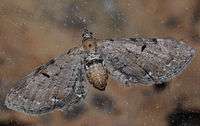Wormwood pug
| Wormwood pug | |
|---|---|
 | |
 | |
| form goossensiata | |
| Scientific classification | |
| Kingdom: | Animalia |
| Phylum: | Euarthropoda |
| Class: | Insecta |
| Order: | Lepidoptera |
| Family: | Geometridae |
| Genus: | Eupithecia |
| Species: | E. absinthiata |
| Binomial name | |
| Eupithecia absinthiata | |
| Synonyms | |
| |
The wormwood pug (Eupithecia absinthiata) is a moth of the family Geometridae. It is a common species across the Palearctic region and the Near East, as well as North America.

The wingspan is 21–23 mm and the forewings are warm brown with two black spots along the costa with a black discal spot completing a distinctive triangle. There is a narrow pale line near the fringe with a distinct whitish spot near the tornus, although this is not as prominent as in the rather similar currant pug. The hindwings are greyish brown. The species flies at night in June and July and is attracted to light.
As the name suggests, the larva feeds on the flowers of mugwort (which is sometimes called "common wormwood"), but it will also feed on the flowers of a range of other plants (see list below). The species overwinters as a pupa.
Larval food plants
- Achillea
- Aconitum
- Artemisia
- Aster
- Calluna – heather
- Cirsium – creeping thistle
- Erica
- Eupatorium
- Pimpinella – burnet-saxifrage
- Senecio
- Solidago – goldenrod
- Tanacetum
- Tripleurospermum – mayweed
References
- Chinery, Michael. Collins Guide to the Insects of Britain and Western Europe (1986, reprinted 1991)
- Skinner, Bernard. Colour Identification Guide to Moths of the British Isles (1984)
External links
| Wikimedia Commons has media related to Eupithecia absinthiata. |